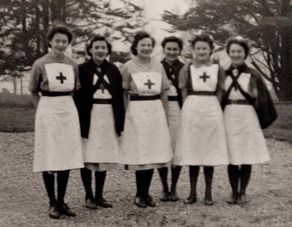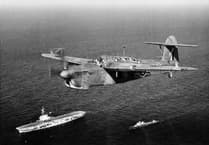Kathleen Oates - a Wren assigned to the Women's Royal Naval Service during the Second World War - was transferred to the Isle of Man in 1944, where she would stay for almost 18 months. During her time on the island, she wrote dozens of letters to home which provide a unique commentary on the operations at Ronaldsway and what life was like on the Isle of Man 80 years ago. Her daughter, CHRISTINE SMITH, pores through her mother’s letters as part of a series of columns based on Kathleen Oates’s writing...
Her letters do not reveal how she came by her injury, but to the end of her life, Wren Kathleen Oates had a scar on her leg, several inches long, which remained white, however tanned the rest of her became. She said she had fallen onto some metal on a Manx beach. In fact, the beaches had no heavy anti-landing craft structures, unlike the rest of the UK, but they did have barbed wire on posts* - and this is doubtless why, eighty years ago this week, Kathleen found herself in the Ronaldsway Sick Bay for a good few days.
The first that her parents, Chris and Elsie Oates, may have heard of the accident, came from a deliberately reassuring letter, posted August 2, by the Second Officer, stating that Kathleen was ‘looking extremely well and cheerful; she said her leg was not hurting very much.’
In fact, the wound had caused concern in Sick Bay; for days, Kathleen’s status was ‘strict bed’. Later in the week, Kathleen wrote of how when she worried over the initial unsightly appearance of her leg, ‘I mentioned the fact to Sister and she practically replied, “Don’t grumble – you’re lucky to have your leg!” Apparently if it had been any deeper it would have been very serious.’.
Once Kathleen was able to write, it was clear that the Sick Bay medical staff were throwing a good percentage of their medical cabinet at her. She wrote of having stitches, taking M&B tablets, which made her feel sick and dizzy, anti-gangrene tablets, Vitamin C pills and ‘pencillian’ [sic] treatment: the antibiotic was so new that she didn’t know how to spell it.
M&B tablets got their name from the manufacturer, May and Baker, and were a new drug, having been first prescribed in 1938. They were widely used in the War, most famously helping Winston Churchill survive pneumonia, before being superseded by new antibiotics, such as penicillin. Penicillin was even newer, only starting to be produced in quantities from 1941-2. Kathleen commented that ‘Sister says that it’s only Service hospitals that are lucky enough to have penicillin – very few civilian hospitals have it.’.
Being in Sick Bay did not mean that she was shut off from goings-on at Ronaldsway. She was content with the view from the window. ‘I can see the Barracudas flying past the window. Unfortunately, I can’t see the sea from my bed as the windows are too high. I can see the seagulls though especially at lunchtime when they’re fed from the scraps we leave.’ More importantly, her friends Cynthia and the Janes especially, visited daily with news. On August 6, ‘Cynthia came to see me. She spent the afternoon playing tennis in a Wrens team against the WAAF [Women's Auxiliary Air Force]. The two Janes were on duty.’
.jpg?trim=17,0,330,0&width=752&height=501&crop=752:501)
Being ill didn’t stop Kathleen from thinking yet again about her future. ‘My Demob date grows perilously nearer. The first 49 groups of the majority of categories are to be demobbed by Sept – so I shouldn’t be at all surprised if I’m home for Christmas, or soon after that. When I’m out of Sick Bay it will be a case of making the best of the few carefree months that remain! I definitely shan’t be getting my 3 year stripe, or reaching the exalted rank of Petty Officer! Cynthia says there’s a list up on the noticeboard about teaching, so I’ve asked her to put my name down.’
By August 7, Kathleen had company in Sick Bay, for various reasons, reflecting War work, and the lack of affordable dentistry in pre-NHS times. ‘There are three other girls in now. One has had a sore throat and temperature, the other dropped a box of bombs on her big toe and broke it and the third has had a terribly swollen face, and a discharge all caused from bad teeth - she’s had an awful lot of pain but luckily the cause has been located and two teeth extracted.’
Also in her August 7 letter, she reported a Royal visitor to Ronaldsway. ‘I missed an interesting incident in the control tower. King Peter of Yugoslavia paid us a visit in a Corsair – just practising flying. He wandered all round the Control Tower and had lunch in the Wardroom with the Officers. We have an Officer’s Steward who waits at table, in our cabin – so I’ll probably hear all about it from her. Cynthia passed him when he was driving to Camp and she said what a keen intelligent face he has.’ It seems that this visit was very low key: there was nothing about King Peter in Manx newspapers, nor any mention of VIP visitors in the Ronaldsway Watch Log. King Peter was deposed later that year, when Yugoslavia was declared a Republic, and lived in the USA until his death in 1970.
Very sadly, Kathleen’s August 8 letter reported tersely ‘another prang last night – all the crew lost’. The Isle of Man Examiner gave more detail: it was a Barracuda aircraft, engaged in anti-submarine exercises off Port Soderick. It was making its third run over the target and had dropped its bombs, but failed to come out of a dive and crashed into the sea. The Pilot was 19 years old.
*Many thanks to the Manx Aviation and Military Museum for clarifying and validating Kathleen’s vague description of barbed wire on a beach, decades later, and for checking for mentions of King Peter.

.jpeg?width=209&height=140&crop=209:145,smart&quality=75)

.jpeg?width=209&height=140&crop=209:145,smart&quality=75)
